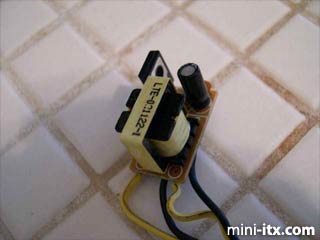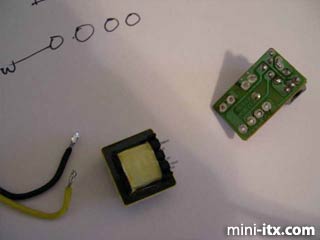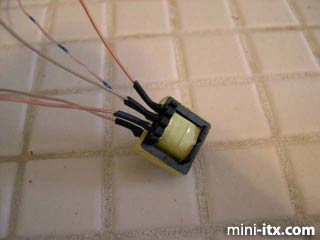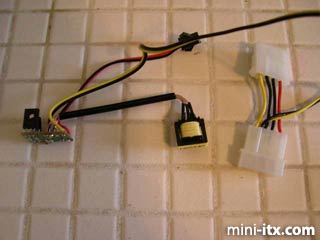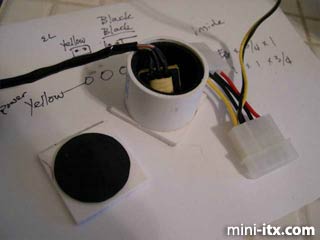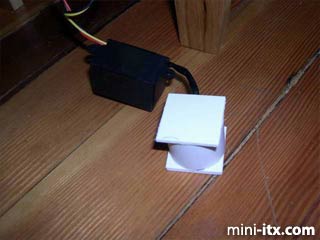Posted on December 15, 2004
EL Inverter Silencing
aka a method to make an EL inverter much more quiet
Here's an inverter out of the case. This is probably the correct time to note that: Doing this probably isn't very safe. You risk breaking the inverter and/or damaging your power supply. I'm sure this mod has negative effects on the longevity of the inverter at the very least. Also, as always, use common sense. EL inverters create high voltages. Your mileage may vary. End of lecture. Let's check out the hack.
EL inverters put out a really irritating noise. It really annoyed me that I had set out to build a silent Linux box and my main case mod gave it an annoying high-pitched whine. I would be really curious to see what others have done about this problem.
Before trying this hack I bought an inverter from a website which claimed to sell "silent" inverters. Unfortunately, when the new inverter arrived it turned out that although the inverter seemed a little bit more quiet, it was also higher-pitched and thus way more annoying. Back to the drawing board.
After building a couple of foam boxes in an attempt to muffle the inverters, I still wasn't able to get any of them as quiet as I would have liked. One day while I was trying different things, I noticed that if you put an inverter in a PVC pipe and sealed the ends, the noise was cut off quite well.
The problem with putting an EL inverter in a sealed PVC pipe is that they can get really hot, so putting the entire inverter in a section of pipe and then sealing it wasn't a practical solution. Later I had an idea. I theorized that most of the heat was probably coming from the resistors and capacitors, and most of the noise was probably coming from the coil.
Only way to test the idea was to take the coil off.
Once the coil was off, I took five pieces of wire about three inches long and soldered them to the coil. Three inches is probably a good length. Heat shrink tubing all around.
I used heat shrink tubing on everything, and re-attached the coil to the circuit board.
After this, I hooked eveything back up again and ran it for a couple of hours. I found that my theory had been correct. As a matter of fact, the coil doesn't seem to heat up at all and it generates almost all of the buzzing.
Since the coil doesn't get hot, it's safe to seal it up in something. I built a chamber out of PVC. For extra insulation, I put some 1/8 inch thick hobby foam on the inside of it. My goal was to make it sealed up well but definitely not airtight.
Here's the completed PVC silencing chamber. I put the rest of the components back in the original case and fired it up.
Success!
 |
 |
 |
Quick Links
Mailing Lists:
Mini-ITX Store
Projects:
Show Random
Accordion-ITX
Aircraft Carrier
Ambulator 1
AMD Case
Ammo Box
Ammo Tux
AmmoLAN
amPC
Animal SNES
Atari 800 ITX
Attache Server
Aunt Hagar's Mini-ITX
Bantam PC
BBC ITX B
Bender PC
Biscuit Tin PC
Blue Plate
BlueBox
BMW PC
Borg Appliance
Briefcase PC
Bubbacomp
C1541 Disk Drive
C64 @ 933MHz
CardboardCube
CAUV 2008
CBM ITX-64
Coelacanth-PC
Cool Cube
Deco Box
Devilcat
DOS Head Unit
Dreamcast PC
E.T.PC
Eden VAX
EdenStation IPX
Encyclomedia
Falcon-ITX
Florian
Frame
FS-RouterSwitch
G4 Cube PC
GasCan PC
Gingerbread
Gramaphone-ITX-HD
GTA-PC
Guitar PC
Guitar Workstation
Gumball PC
Hirschmann
HTPC
HTPC2
Humidor 64
Humidor CL
Humidor II
Humidor M
Humidor PC
Humidor V
I.C.E. Unit
i64XBOX
i-EPIA
iGrill
ITX Helmet
ITX TV
ITX-Laptop
Jeannie
Jukebox ITX
KiSA 444
K'nex ITX
Leela PC
Lego 0933 PC
Legobox
Log Cabin PC
Lunchbox PC
Mac-ITX
Manga Doll
Mantle Radio
Mediabox
Mega-ITX
Micro TV
Mini Falcon
Mini Mesh Box
Mini-Cluster
Mobile-BlackBox
Moo Cow Moo
Mr OMNI
NAS4Free
NESPC
OpenELEC
Osh Kosh
Pet ITX
Pictureframe PC
Playstation 2 PC
Playstation PC
Project NFF
PSU PC
Quiet Cubid
R2D2PC
Racing The Light
RadioSphere
Restomod TV
Robotica 2003
Rundfunker
SaturnPC
S-CUBE
SEGA-ITX
SpaceCase
SpacePanel
Spartan Bluebird
Spider Case
Supra-Server
Teddybear
Telefunken 2003
TERA-ITX
The Clock
ToAsTOr
Tortoise Beetle
Tux Server
Underwood No.5
Waffle Iron PC
Windows XP Box
Wraith SE/30
XBMC-ION

